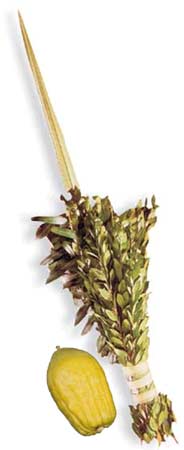
The Midrash (Vayikra Rabbah 30:12) teaches that the four kinds that we “shake” on Sukkos are symbolic of the four different types of Jews, taste representing Torah knowledge and a pleasant aroma representing good deeds:
- Esrog (unusual citrus fruit): has taste and a pleasant aroma, and thus represents those who are both accomplished Torah scholars and doers of good deeds;
- Lulav (a frond from a palm tree): has tasty dates, but no aroma, representing dedicated Torah scholars;
- Haddasim (myrtle branches): only has a pleasant aroma, representing those who excel in good deeds but not in Torah study;
- Arovos (willow branches): have neither taste nor fragrance, which represents the simple Jews who, though lacking distinction through Torah scholarship or good deeds, serve Hashem with simple faith.
(It should be noted that everyone should (and is obligated to!) study Torah, but only some can be said to excel in Torah study. Similarly, everyone should engage in good deeds, but only some are meant to do so in an exceptional manner.)
After explaining this teaching to a beginner, he commented: “So we should all become Esrogim!”
I responded that according to my understanding, this is incorrect. Although the combination of Torah study and good deeds is clearly a special quality, it may also have a drawback. Those Jews who lack excellence in Torah knowledge but are dedicated to helping others typically (but not always) excel in their good deeds more than those who engage in both Torah study and good deeds. The same goes for dedicated Torah scholars who do not engage in good deeds vis-a-vis those who do not. Likewise, as mentioned, those who lack other qualities but serve Hashem with simple faith excel in the purity of their faith. Thus, each Jew should excel in the area/s in which s/he is gifted.
The Midrash says that the act of bringing together the four kinds represents creating unity between the four different types of Jews.
Most of the time we have little difficulty realizing our own talents and skills. However, recognizing and appreciating the good qualities of others, especially when their areas of excellence differ radically from one’s own, is not so easy. It requires the humility to understand that as great as one may (or may not!) be, one is only a part of the whole, a whole that is fundamentally lacking without the vital contributions of everyone. Even the Esrog Jew needs to unite with the other kinds through recognizing their respective virtues, which in a sense he lacks (as explained).
When each person both maximizes his own individual potential, and recognizes that he is an integral part of a whole, then he can truly complement others, and together they can attain the special common goal that can only be reached through this process of uniting through complementing.
This post was dedicated by Dan Schechter and family as a merit for Moshe ben Yehuda.
Like what you read? The articles I write take a lot of time and effort. Please contact me to sponsor an article for $36 in honor of the birthday, wedding anniversary, or yarhtzeit of a loved one, or for a refuah shleimah or the like. Also, see here concerning the tremendous merit of supporting the dissemination of Chassidus, and the blessings that one receives for doing so.
No comments:
Post a Comment
Thank you for your comment! :)